CaptiveAire M511, CAV-M, CAH-M Installation Manual
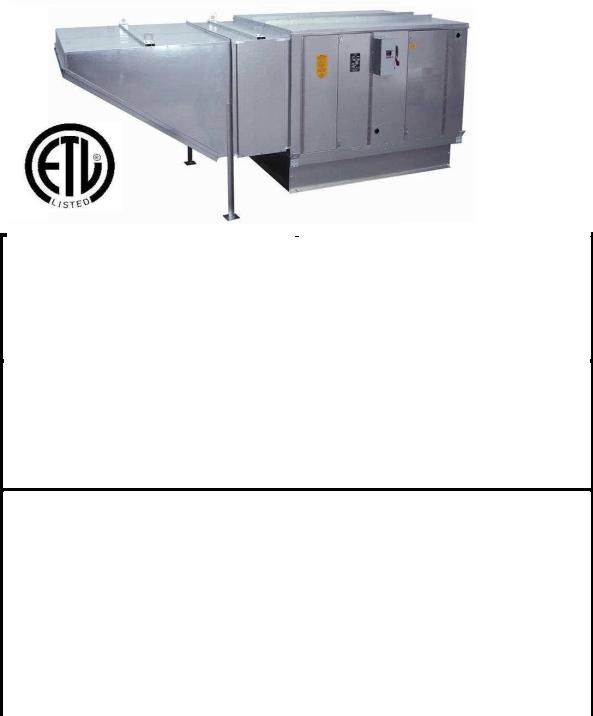
Installation & Operation Guide
Industrial Direct Fired Heaters
Horizontal / Vertical and Single / Twin Blowers
Re-Circulating Systems
Static Pressure Controller – Potentiometer
|
|
FOR YOUR SAFETY |
FOR YOUR SAFETY |
|
If You smell gas: |
The use and storage of gasoline or |
|
1. |
Open windows |
other flammable vapors and liquids in |
|
2. |
Don’t touch electrical switches |
open containers in the vicinity of this |
|
3. |
Extinguish any open flames |
appliance is hazardous! |
|
4. |
Immediately call your gas supplier |
|
|
WARNING!!
Improper installation, adjustment, alteration, service or maintenance can cause property damage, injury or death. Read the installation, operating and maintenance instructions thoroughly before installing or servicing this equipment.
ALWAYS disconnect power and gas prior to working on heater.
RECEIVING AND INSPECTION
Upon receiving unit, check for any interior and exterior damage, and if found, report it immediately to the carrier. Also check that all accessory items are accounted for and are damage free. Turn the blower wheel by hand to verify free rotation and check the damper (if supplied) for free operation.
NOTE TO INSTALLER |
NOTE TO INSTALLER |
Please complete and return the |
This manual should be reviewed with |
Start-UP Checklist on the back of this |
the customer and left with the |
manual to validate warranty |
equipment user |
|
|
|
Revision 7 – 5.25.2010 |
2
TABLE OF CONTENTS |
|
WARRANTY.................................................................................................................................... |
4 |
INSTALLATION ............................................................................................................................... |
4 |
Gas ................................................................................................................................................ |
11 |
Electrical ........................................................................................................................................ |
12 |
Gas Connection Diagram .............................................................................................................. |
12 |
Copper Wire Ampacity .......................................................................................................... |
12 |
Re-Circulating Damper Control Options ........................................................................................ |
14 |
SEQUENCE OF OPERATIONS.................................................................................................... |
16 |
Sequence of Operation – 80/20 Static Pressure Contr oller ................................................ |
16 |
Sequence of Operation – 80/20 Manual Potentiometer ....................................................... |
16 |
START-UP PROCEDURE 80/20 .................................................................................................. |
18 |
AIR BALANCING ........................................................................................................................... |
24 |
TEMPERATURE CONTROL SYSTEMS ...................................................................................... |
26 |
UNIT COMPONENTS ................................................................................................................... |
27 |
M4RT1 Flame Safety Control ............................................................................................... |
27 |
DC Flame Signal................................................................................................................... |
27 |
Air Flow Switch ..................................................................................................................... |
28 |
Modulating Gas System........................................................................................................ |
28 |
High Temperature Limit ........................................................................................................ |
28 |
TROUBLESHOOTING .................................................................................................................. |
30 |
General Maintenance .................................................................................................................... |
42 |
Burner Orifice Drill Size........................................................................................................ |
43 |
START-UP CHECKLIST ............................................................................................................... |
43 |
3
WARRANTY
This equipment is warranted to be free from defects in materials and workmanship, under normal use and service, for a period of 12 months from date of shipment. This warranty shall not apply if:
•the equipment is not installed by a qualified installer per the manufacturer’s installation instructions shipped with the product
•the equipment is not installed in accordance with federal, state and local codes and regulations
•the equipment is misused or neglected
•the equipment is not operated within its published capacity
•the invoice is not paid within the terms of the sales agreement
•the Start-Up Checklist has not been filled in by a qualified technician and returned to the Factory Service Department
The manufacturer shall not be liable for incidental and consequential losses and damages potentially attributable to malfunctioning equipment. Should any part of the equipment prove to be defective in material or workmanship within the 12-month warranty period, upon examination by the manufacturer, such part will be repaired or replaced by manufacturer at no charge. The buyer shall pay all labor costs incurred in connection with such repair or replacement. Equipment shall not be returned without manufacturer’s prior authorization and all returned equipment shall be shipped by the buyer, freight prepaid to a destination determined by the manufacturer.
NOTE TO INSTALLER
Please complete and return the
Start-UP Checklist on the back of this manual to validate warranty
INSTALLATION
It is imperative that this unit is installed and operated with the designed airflow, gas, and electrical supply in accordance with this manual. Any variance to these instructions may cause the unit to not perform to specifications and may cause severe damage to the unit or jobsite. Please call the service department at 1-800-291-2452 for assistance on warranty issues and technical support.
Inspection on Arrival
1.Inspect unit on delivery
2.Photograph any visible damage
3.Report any damage to the delivery carrier
4.Request a written inspection report from the Claims Inspector to substantiate claim
5.File claims with delivery carrier
6.Check unit’s rating plate to verify proper electric and fuel type to meet job requirements
7.Compare unit received with description of product ordered
Unit Location
1.Do not locate any gas-fired equipment near corrosive or explosive vapors such as chlorinated or acid vapors
2.Avoid overhead power lines, or other utility access to prevent accidental contact or damage.
3.Provide clearance around installation site to safely rig and lift the equipment into its final
4
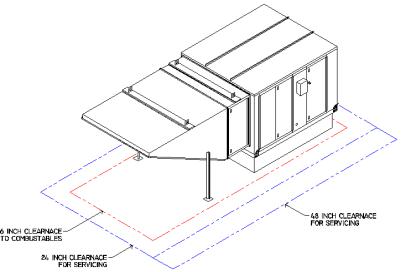
position onto adequate supports. Refer to the manufacturer’s estimated weights.
4.Consider general service and installation space when locating the unit.
5.Locate the unit close to the space it will serve to reduce long, twisted duct runs.
6.Do not allow air intake to face prevailing winds. Air flow switch may trip in high winds.
7.Situate the unit above ground or at roof level high enough to prevent precipitation from being drawn into its inlet.
8.The inlet must also be located at least 10 feet away from any exhaust vents.
9.The heater inlet must be located in accordance with the applicable building code provisions for ventilation air.
10.All air to the heater must be ducted from the outdoors.
11.Recirculation of room air is not permitted. If in doubt regarding the application, consult the manufacturer.
12.The unit must have adequate structural support or the equipment or building could be damaged.
13.Do not alter or otherwise restrict combustion or ventilation openings.
14.Direct-fired units should not be installed downstream from cooling systems which use refrigerants for cooling.
COMBUSTABLE
CLEARANCES
The top, back, and front surfaces of this heater may not be installed less than 6 inches from combustible materials. The heater base may be installed on combustible surfaces.
SERVICE CLEARANCES
Allow 24 inches or greater minimum service clearance on all sides of this heater. Allow 48 inches or greater on the vestibule and blower door side.
Rigging
1.Size 10, 12, 15, and 18 units are supplied with lifting eyes on the top corners of the casing.
2.All other units are supplied with four mounting and lifting brackets on the bottom corners of the base with holes for lifting hooks.
3.The main load should be on these lugs.
4.Lift the unit and accessories separately, and attach the accessories to the unit once the unit is in place.
5.The following diagrams represent the proper methods for lifting the unit and accessories.
6.Always use spreader bars to prevent damage to the unit casing.
5
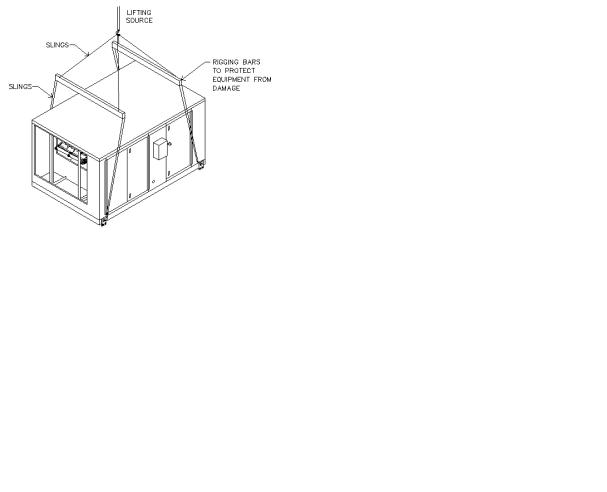
FIGURE 1: SIZE 10, 12, 15, & 18
FIGURE 3: WITH SPREADER BARS
CAUTION!!
These are unbalanced loads Lift equipment gently
Do not jerk
FIGURE 2: NO SPREADER BARS
FIGURE 4: ACCESSORIES
WARNING!!
Spreader bars must be used and should extend past the edges of the equipment to avoid damage to the casing. Not using spreader bars may cause damage to the casing
WARNING!!
Damage will result if the equipment is raised by the intake hood, blower, motor shaft, or bearings Use the provided lifting eyes and brackets on the unit
6
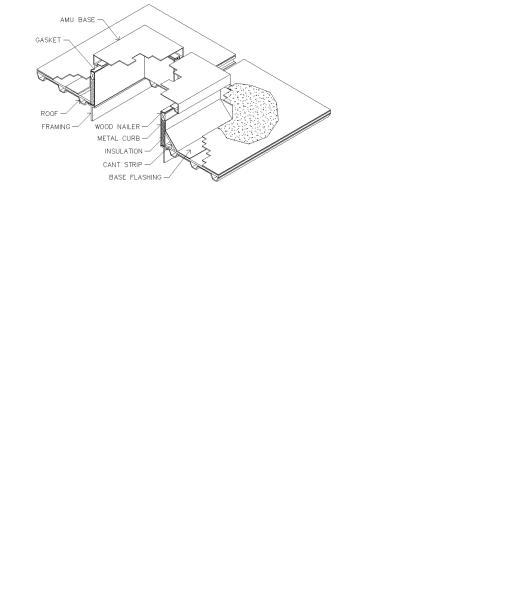
Curbs
The unit must have adequate structural support or the equipment or building could be damaged. The curb and unit must be leveled or the unit may leak or be damaged. Use gasket and caulk between the curb and unit. Use shims if necessary to level the unit. Screw or weld the unit’s base to the curb to avoid damage to the equipment.
WARNING!!
The unit must have adequate structural support or the equipment or building could be damaged.
WARNING!!
Screw or weld the unit’s base to the curb to avoid damage to the equipment.
WARNING!!
The curb and unit must be leveled or the unit may leak or be damaged.
Accessories
Intake and discharge accessories are shipped loose and unassembled. When attaching the accessories to the unit use gasket, caulk, and #10 sheet metal screws on all seams. All accessories must be level them may leak and or be damaged.
WARNING!! |
WARNING!! |
Use gasket, caulk, and #10 sheet metal screws on |
The accessories must be level and support legs |
all component intersections. Leaking may result if |
attached to the hood and solid part of the roof. |
the intersections are not completed properly. |
Equipment that is not level or properly supported |
|
may leak or be damaged. |
7
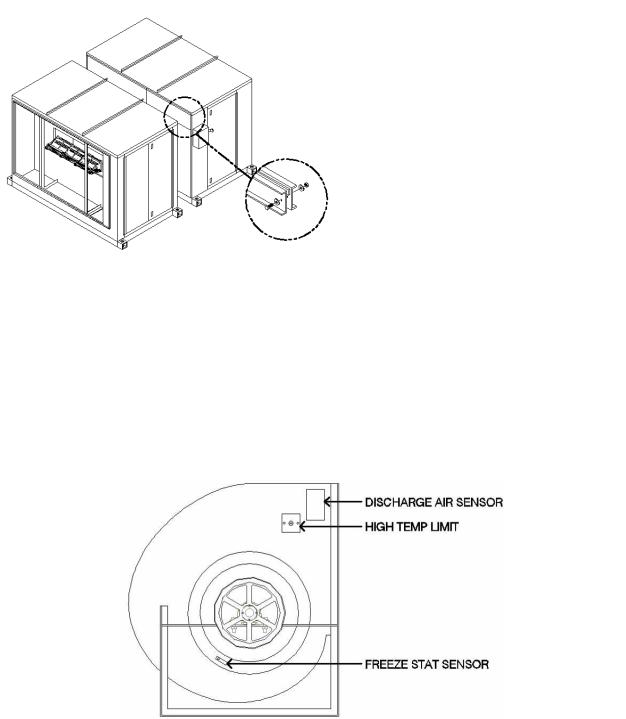
Split Units
1.Apply weather-proof gasket to the seam of the vertical or horizontal unit
2.Use provided fasteners to secure the seam of the unit using the provided pre-punched holes
a.Horizontal units internal channels and a formed frame
b.Vertical units have angles on the outside of the casing
FIGURE 1: HORIZONTAL SPLIT ASSEMBLY |
FIGURE 2: VERTICAL SPLIT ASSEMBLY |
3.Apply silicone to the outside edge of the seam
4.Field wire the discharge air sensor using a minimum 22 gauge wire
5.Mount the high temperature limit bulb to the blower housing
6.Mount the (optional) freeze control sensor to the blower housing
FIGURE 3: BLOWER SENSOR FIELD ASSEMBLY
8

Shipped Loose Intake or Discharge Dampers
In some cases an intake or discharge damper may be shipped loose. This may be requested by the customer or can be required because of larger units shipping size restrictions. Follow these instructions to attach and wire the shipped loose damper. Factory mounted dampers may be attached on the unit and will not require assembly or field wiring.
1.Attach the damper to the intake or discharge using gasket, caulk, and #10 sheet metal screws
2.Field wire the damper using the as built wiring schematic for the specific unit. Wiring may be different depending on the model and options selected.
3.Refer to the factory supplied wiring print to verify the field wiring terminals.
Ductwork
This fan was specified for a specific CFM and static pressure. The ductwork attached to this unit will significantly affect the airflow performance.
WARNING!!
•Flexible ductwork and square elbows should not be used
•Transitions and turns in ductwork near the fan outlet will cause system effect and will drastically increase the static pressure and reduce airflow
•The Ductwork Sizing Chart shows the minimum fan outlet duct sizes and straight lengths recommended for optimal fan performance
•Units with twin blower must have a common discharge plenum
Follow SMACNA guides and recommendations for the remaining duct run. Fans designed for rooftop installation should be installed on a prefabricated or factory-built roof curb. Follow curb manufacturer’s instructions for proper curb installation. The unit should be installed on a curb and/or rail elevated not less than 20” above any surface. Be sure the duct connection and fan outlet are properly aligned and sealed.
Adequate building relief is necessary in order to prevent over-pressurizing the building when the heater is operating at capacity. This can be accomplished by establishing properly-sized relief openings, an interlocked, powered exhaust system, or both.
Heaters installed with intake ductwork must be purged to replace at least four air changes of the volume of the intake duct.
In order to avoid hazards to other fuel-burning equipment in the building (i.e., when the heater is providing make-up air to a boiler room), the unit should be interlocked to open inlet air dampers or other such devices.
On outdoor installations, it is recommended that the discharge duct be insulated to prevent condensation during the “OFF” cycle in cold weather.
Units being installed in airplane hangars should be installed in accordance with the Standard for Aircraft Hangars, ANSI/NFPA 409. Units being installed in public garages should be installed in accordance with the Standard for Parking Structures, ANSI/NFPA 88A, or the Standard for Repair Garages, ANSI/NFPA 88B, and with CAN/CGA B149 Installation Codes.
Flexible connectors should be employed on all ductwork connections. Vibration isolators are optional and can be supplied in the loose parts package.
To isolate the blower and motor, a spring mounted combination blower/motor base can be factory mounted in the unit. A flexible fabric connector is used to isolate the base from the unit’s discharge opening flange.
9
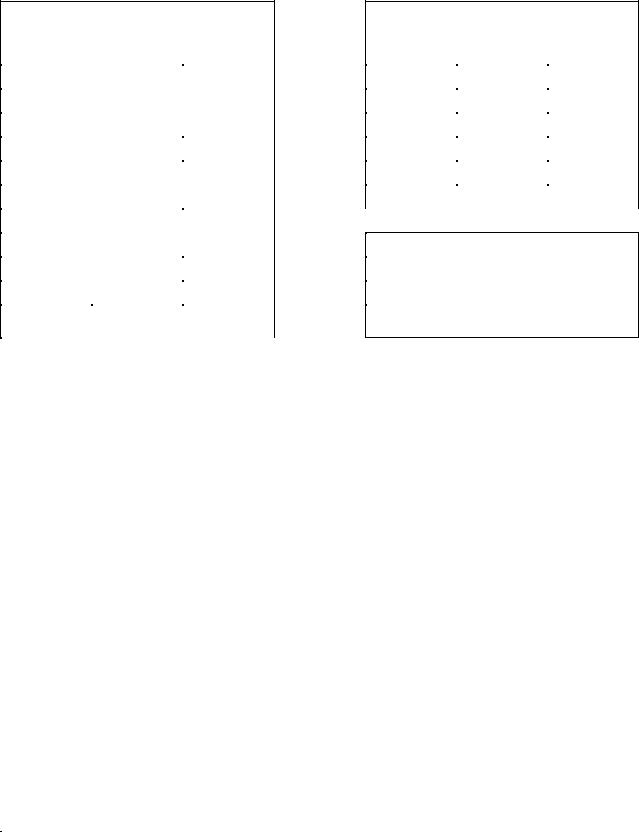
Ductwork Sizing Chart Single Blower
Blower Size |
Duct Size |
Duct Length |
|
(Inches) |
(Inches) |
|
|
|
10 |
14 x 14 |
30 |
|
|
|
12 |
16 x 16 |
36 |
|
|
|
15 |
20 x 20 |
45 |
|
|
|
18 |
24 x 24 |
54 |
|
|
|
20 |
26 x 26 |
60 |
|
|
|
22 |
30 x 30 |
66 |
|
|
|
25 |
32 x 32 |
75 |
|
|
|
27 |
36 x 36 |
81 |
|
|
|
30 |
38 x 38 |
90 |
|
|
|
33 |
44 x 44 |
99 |
|
|
|
36 |
44 x 44 |
108 |
|
|
|
Installation Examples
Ductwork Sizing Chart Dual Blowers
Blower Size |
Duct Size |
Duct Length |
|
(Inches) |
(Inches) |
|
|
|
222 |
77 x 28 |
66 |
|
|
|
225 |
88 x 32 |
75 |
|
|
|
227 |
96 x 36 |
81 |
|
|
|
230 |
104 x 38 |
90 |
|
|
|
233 |
116 x 44 |
99 |
|
|
|
236 |
122 x 44 |
108 |
|
|
|
WARNING!!
Failure to undersize ductwork size or length may cause system affect and reduce the performance of the equipment.
Using the unit to support the ductwork may cause damage to the units casing.
|
|
Figure 1: Horizontal Roof Top Installation |
Figure 2: Vertical Outdoor Ground Installation |
Down discharge AMU reduces ductwork |
Side discharge AMU reduces ductwork |
Hood weight supported by support legs |
Support stand on concrete pad |
Union, regulator, and shut-off |
Union, regulator, and shut-off |
Roof curb supports unit |
Filter section inside support stand |
Intake facing away from prevailing winds |
Ease of serviceability on ground |
10
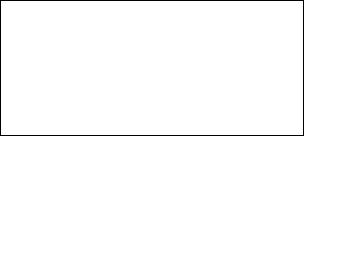
Gas
Gas piping must be installed to conform with local building codes, or in the absence of local codes, the National Fuel Gas Code, ANSI Z223.1 (NFPA 54) – latest edition. In Canada, gas piping must be installed in accordance with CAN/CGA-B149.1 for natural gas units and CAN/CGA-B149.2 for propane units.
WARNING
Inlet gas pressure must not exceed pressure indicated on name plate.
Refer to the heater rating plate for determining the minimum gas supply pressure for obtaining the maximum gas capacity for which this heater is specified.
1.Always disconnect power before working on or near a heater. Lock and tag the disconnect switch or breaker to prevent accidental power-up.
2.Piping to the unit should conform to local and national requirements for type and volume of gas handled, and pressure drop allowed in the line. Refer to the Gas Engineer’s Handbook for gas line capacities.
3.The incoming pipe near the heater should be sized to match the connection on the outside of the unit. Unit inlet sizes are shown in the table to the right. Avoid multiple taps in the gas supply so the unit has a steady supply of gas at all times.
4.Install a ground joint union with brass seat and a manual shut-off valve external to the unit casing, as shown below, adjacent to the unit for emergency shut-off and easy servicing of controls.
5.Provide a sediment trap, as shown below, before each unit and where low spots in the pipe line cannot be avoided.
6.Blow out the gas line to remove debris before making connections. Before starting the unit, purge line to remove air. Purge air from gas lines according to ANSI Z223.1- latest edition “National Fuel Gas Code,” or in Canada: CAN/CGA-B149.
7.All field gas piping must be pressure/leak tested prior to operating the unit. Use a soap solution or equivalent for leak testing. The heater and its individual shut-off valve must be disconnected from the gas supply piping system during any pressure testing of that system at test pressures in excess of ½ PSI. During any pressure testing of the gas
supply piping system at test pressures equal to or less than ½ PSI, the heater must be isolated from the gas supply piping system and its individual manual shutoff valve closed.
8.This unit requires the gas pressure to be within the unit’s minimum and maximum gas pressure ratings. If the pressure is greater than the maximum, the internal valve components will be damaged. If the pressure is below the minimum, the heater will not perform to specifications.
9.If installing on a paint booth application, a manual shutoff should be located for access in case of a fire or explosion at the heater.
Gas Connection Sizes
|
Gas Pressure (Inches W.C. & PSI) |
||||
BTU Input |
7” – 14” |
15” – 1# |
1# - 5# |
||
158,000 |
½ |
½ |
|
½ |
|
275,000 |
¾ |
½ |
½ |
||
550,000 |
¾ |
¾ |
¾ |
||
990,000 |
|
1 |
¾ |
¾ |
|
1,375,000 |
1 |
¼ |
¾ |
¾ |
|
1,650,000 |
1 |
¼ |
¾ |
1 |
|
1,925,000 |
1 |
½ |
1 |
|
1 |
2,475,000 |
1 |
½ |
1 ¼ |
1 |
|
2,750,000 |
|
2 |
1 |
¼ |
1 ¼ |
3,300,000 |
|
2 |
1 |
½ |
1 ¼ |
4,125,000 |
2 |
½ |
1 ½ |
|
1 ¼ |
5,225,000 |
2 |
½ |
1 ½ |
|
1 ½ |
5,775,000 |
2 |
½ |
2 |
|
1 ½ |
6,325,000 |
|
3 |
|
2 |
1 ½ |
8,525,000 |
|
3 |
2 |
½ |
1 ½ |
9,075,000 |
|
|
2 |
½ |
2 ½ |
9,625,000 |
|
|
|
3 |
2 ½ |
11,825,000 |
|
|
|
3 |
3 |
15,552,000 |
|
|
2 |
½ |
3 |
16,848,000 |
|
|
2 |
½ |
3 |
11
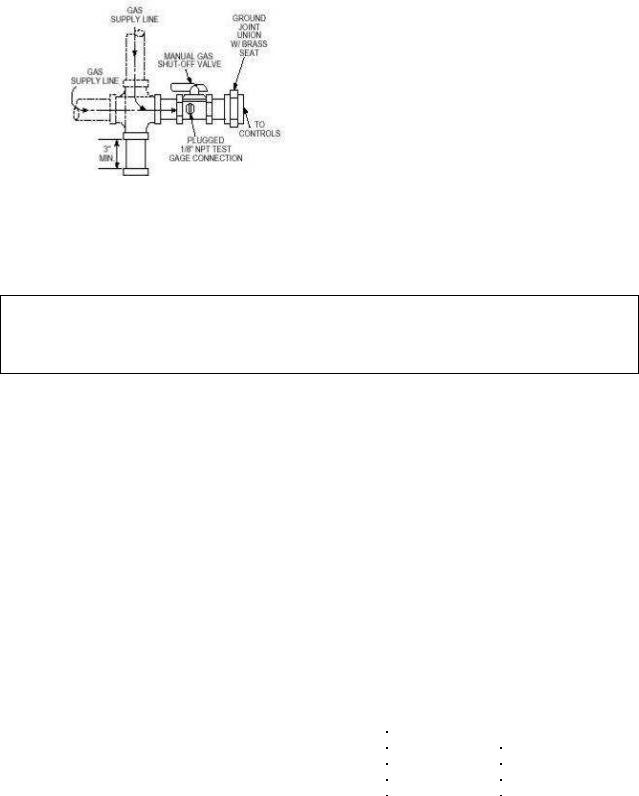
Gas Connection
Diagram
Electrical
Before connecting power to the heater, read and understand this entire section. Wiring diagrams are furnished with each fan by the factory, and are attached to the door of the unit.
WARNING!!
Disconnect power before installing or servicing fan. High voltage electrical input is needed for this equipment. This work should be performed by a qualified electrician.
Electrical wiring must be done in accordance with local ordinances and the National Electric Code, ANSI/NFPA70. Be sure the voltage and phase of the power supply and the wire amperage capacity conform to those listed on the motor nameplate. For additional safety information, refer to AMCA publication 410-96, “Recommended Safety Practices for Users and Installers of Industrial and Commercial Fans.”
1.Always disconnect power before working on or near a heater. Lock and tag the disconnect switch or breaker to prevent accidental power-up.
2.A dedicated circuit should supply the units electrical disconnect with circuit protection, according to the National Electric Code.
3.Make certain that the power source is compatible with the requirements of your equipment. The heater nameplate identifies the proper phase and voltage of the motor.
4.Units shipped with an optional remote panel have two electrical circuit drops. It is important to run the motor wires in a conduit separate from the remote control wiring. The DC wires from the unit temperature controller, located in the control drop, should be either in shielded cable or run in a separate conduit.
5.Before connecting the heater to the building power source, verify the power line wiring is deenergized.
6.Secure the power cables to prevent contact with sharp
objects.
7.Do not kink power cable and never allow the cable to come in contact with oil, grease, hot surfaces or chemicals.
12
Copper Wire Ampacity
Wire Size AWG |
Maximum Amps |
14 |
20 |
12 |
25 |
10 |
30 |
8 |
40 |
6 |
55 |
4 |
70 |
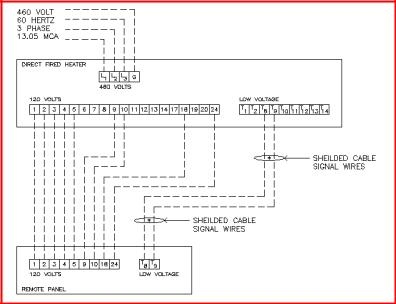
8.Before powering up the heater, check fan wheel for free rotation and make sure that the interior of the heater is free of loose debris or shipping materials.
9.If necessary, the original wire supplied with the heater may be replaced with type TW wire or the equivalent.
Remote Control Panel
For units with the optional remote control panel, a terminal strip inside the panel matches the terminals in the heater unit. This diagram shows an example of the field wiring for a unit with a 401M remote panel. Consult the as built wiring print supplied with the equipment. Most remote panels and VAV applications have signal wiring which needs to be shielded cable to avoid high voltage interference.
Power Supply Wiring
The units input power supply is listed on the unit nameplate. If the units power supply does not match the unit nameplate contact the service department for a new wiring print and parts.
Paint Booth Applications
If a low temperature control is not an integral part of the heater, it is recommended that one be installed in areas where freeze protection is needed in the event of a burner shutdown. The space should be ventilated following a bake cycle to purge any contaminants and cool product prior to personnel entering the space. If the unit was supplied with paint booth controls from the factory, refer to the schematic for installation of the interlock to disable spraying equipment unless the heater is operating in ventilation mode. Refer to electrical schematic for interlock to disable facility lighting within the process space during the bake cycle.
If they unit will be operating as a process heater in the re-circulating position with airborne particulate matter, install means to facilitate inspection, maintenance, cleaning and access to fire protection devices. In re-circulating process applications, the system shall be designed to provide 200 cfm per 1000 cfh of natural gas based on the maximum capacity of the heater plus an allowance to sufficiently dilute the VOC’s created by the process to maintain the lower explosive level below a 25% threshold value.
13
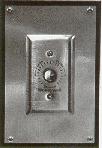
Re-Circulating Damper Control Options
The Re-Circulating system is for controlling the amount of make-up air being brought into a building. It can be set from a minimum 20& fresh air, and 80% return air to a maximum of 100% fresh air, and 0% return air. The Re-Circulating dampers can be controlled by three different options.
Manual Positioning Control (Potentiometer)
The dampers can be control at a remote location by a manual potentiometer to any position from 20% to 100% fresh air. This will allow manually setting the dampers to match the building ventilation requirements. It will take an extra 3 control wires at the remote location. On a power failure, or if the unit of turned off, the return air damper will close by spring return.
Two Position Control
The dampers can be controlled by a two position switch (a field supplied switching device) to open the fresh air to 100%. On opening of the circuit, power failure, or if the unit is shutoff, the return air damper will close by spring return.
Static Pressure Control (Photohelic)
The dampers can be controlled by a building static pressure control. This controller will sense the difference between pressure inside the building, and pressure outside the building (sensed at the A306 outdoor sensor), and position the dampers to maintain the pressure setting on the controller. The controller has two set points and an indicator. The two set points are a minimum desired static pressure point, and a maximum static pressure point.
The actual building static pressure will be shown by a visual indicator between these two settings. The controller will modulate the dampers to maintain a static pressure between these set points.
When building static pressure is below the minimum setting, the damper motor will proportion open the fresh air damper and close the return air damper until static increases above the minimum setting. At this point, the damper motor will stop and hold this proportion.
If the building static continues to climb and goes above maximum setting, the damper motor will reverse proportion, closing the fresh air damper and opening the return air damper until static drops below maximum setting.
During the “OFF” or “Night” cycle of the unit, an i nternal switching circuit will close the return air damper.
See additional wiring and installation information on the static pressure controller and A306 outdoor sensor. The static pressure controller can be ordered to be shipped loose or mounted inside the unit to reduce field wiring and assembly.
14
